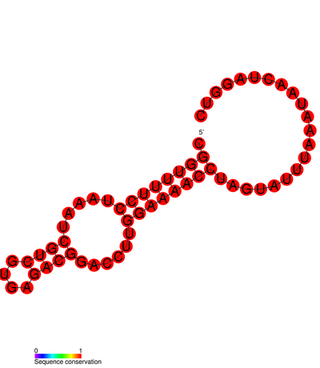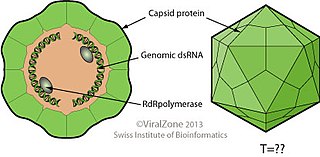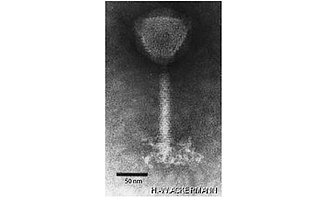Virus classification is the process of naming viruses and placing them into a taxonomic system similar to the classification systems used for cellular organisms.

The genus Marburgvirus is the taxonomic home of Marburg marburgvirus, whose members are the two known marburgviruses, Marburg virus (MARV) and Ravn virus (RAVV). Both viruses cause Marburg virus disease in humans and nonhuman primates, a form of viral hemorrhagic fever. Both are Select agents, World Health Organization Risk Group 4 Pathogens, National Institutes of Health/National Institute of Allergy and Infectious Diseases Category A Priority Pathogens, Centers for Disease Control and Prevention Category A Bioterrorism Agents, and are listed as Biological Agents for Export Control by the Australia Group.

Closteroviridae is a family of viruses. Plants serve as natural hosts. There are four genera and 59 species in this family, seven of which are unassigned to a genus. Diseases associated with this family include: yellowing and necrosis, particularly affecting the phloem.

The International Committee on Taxonomy of Viruses (ICTV) authorizes and organizes the taxonomic classification of and the nomenclatures for viruses. The ICTV has developed a universal taxonomic scheme for viruses, and thus has the means to appropriately describe, name, and classify every virus that affects living organisms. The members of the International Committee on Taxonomy of Viruses are considered expert virologists. The ICTV was formed from and is governed by the Virology Division of the International Union of Microbiological Societies. Detailed work, such as delimiting the boundaries of species within a family, typically is performed by study groups of experts in the families.

Benyvirus is a genus of viruses, in the family Benyviridae. Plant serve as natural hosts. There are four species in this genus. Diseases associated with this genus include: BNYVV: rhizomania.

Iflaviridae is a family of positive sense RNA viruses insect-infecting viruses. Some of the insects commonly infected by iflaviruses include aphids, leafhoppers, flies, bees, ants, silkworms and wasps. The name "Ifla" is derived from the name "Infectious flacherie virus", a member species. There is one genus (Iflavirus) and 16 species in this family.

Aspiviridae, formerly Ophioviridae, is a family of segmented negative-strand RNA viruses which infect plants. Member viruses are characterized by an elongated and highly filamentous and flexible nucleocapsid with helical symmetry. It is a monotypic taxon containing only one genus, Ophiovirus. Aspiviridae is also the only family in the order Serpentovirales, which in turn is the only order in the class Milneviricetes.

Alphaflexiviridae is a family of viruses in the order Tymovirales. Plants and fungi serve as natural hosts. There are 65 species in this family, assigned to six genera. Diseases associated with this family include: mosaic and ringspot symptoms.

Secoviridae is a family of viruses in the order Picornavirales. Plants serve as natural hosts. There are 8 genera and 86 species in this family, one of which is unassigned to a genus. The family was created in 2009 with the grouping of families Sequiviridae, now dissolved, and Comoviridae, now subfamily Comovirinae, along with the then unassigned genera Cheravirus, Sadwavirus, and Torradovirus.

Bicaudaviridae is a family of hyperthermophilic archaeal viruses. Members of the genus Acidianus serve as natural hosts. There is only one genus (Bicaudavirus) and one species in this family: Acidianus two-tailed virus. However, Sulfolobus tengchongensis spindle-shaped viruses 1 and 2 are regarded to belong to this family also.
Proboscivirus is a genus of viruses in the order Herpesvirales, in the family Herpesviridae, in the subfamily Betaherpesvirinae. Elephants serve as natural hosts. EEHV1 is apathogenic for African elephants but causes fatal haemorrhagic disease in Asian elephants. The name "Proboscivirus" comes from the Greek word προβοσκίς or "proboscis" meaning "the elephant trunk," for which the virus accordingly uses as its means of contraction and transmission to enter the elephant's body.

Betacoronavirus 1 is a species of coronavirus which infects humans and cattle. The infecting virus is an enveloped, positive-sense, single-stranded RNA virus and is a member of the genus Betacoronavirus and subgenus Embecovirus. Like other embecoviruses, it has an additional shorter spike-like surface protein called hemagglutinin esterase (HE) as well as the larger coronavirus spike protein.

Megabirnaviridae is a family of double-stranded RNA viruses with one genus Megabirnavirus which infects fungi. The group name derives from member's bipartite dsRNA genome and mega that is greater genome size than families Birnaviridae and Picobirnaviridae. There is only one species in this family: Rosellinia necatrix megabirnavirus 1. Diseases associated with this family include: reduced host virulence.

Quadriviridae is a family of double-stranded RNA viruses with a single genus Quadrivirus. The fungi Rosellinia necatrix serves as a natural host. The name of the group derives from the quadripartite genome of its members where in Latin quad means four. There is only one species in this family: Rosellinia necatrix quadrivirus 1.

Hantaviridae is a family of viruses in the order Bunyavirales. It is named for the Hantan River area in South Korea where an early outbreak of one of its species was observed.
Yingvirus is a genus of negative-strand RNA viruses which infect invertebrates. Member viruses have bisegmented genomes. It is the only genus in the family Qinviridae, which is the only family in Muvirales, which is the only order in Chunqiuviricetes. There are eight species in the genus.
Leporid alphaherpesvirus 4 (LeHV-4) is a species of virus in the genus Simplexvirus, subfamily Alphaherpesvirinae, family Herpesviridae, and order Herpesvirales.
Elephantid betaherpesvirus 4 (ElHV-4) is a species of virus in the genus Proboscivirus, subfamily Betaherpesvirinae, family Herpesviridae, and order Herpesvirales.
Papiine gammaherpesvirus 1 (PaHV-1), commonly known as baboon lymphocryptovirus, is a species of virus in the genus Lymphocryptovirus, subfamily Gammaherpesvirinae, family Herpesviridae, and order Herpesvirales.

Herelleviridae is a family of bacterial viruses of the order Caudovirales infecting members of the phylum Firmicutes. The family has five subfamilies, 33 genera and 92 species.













